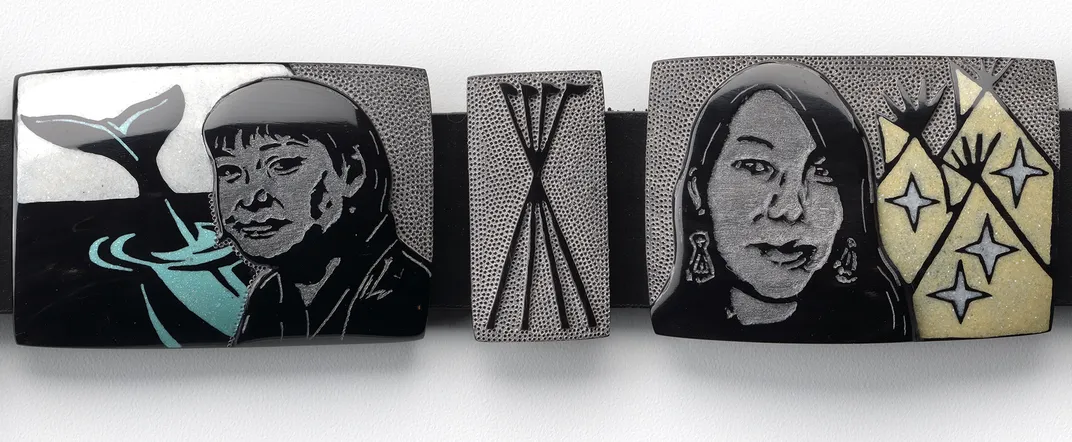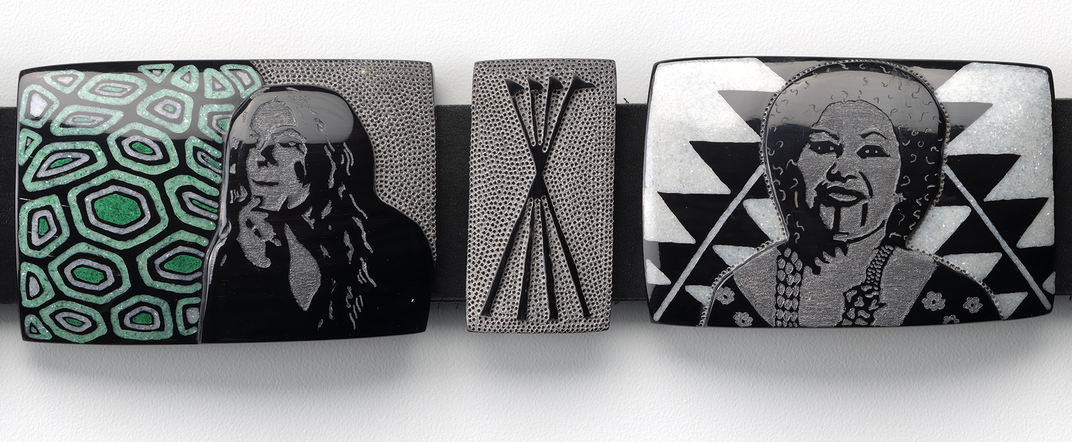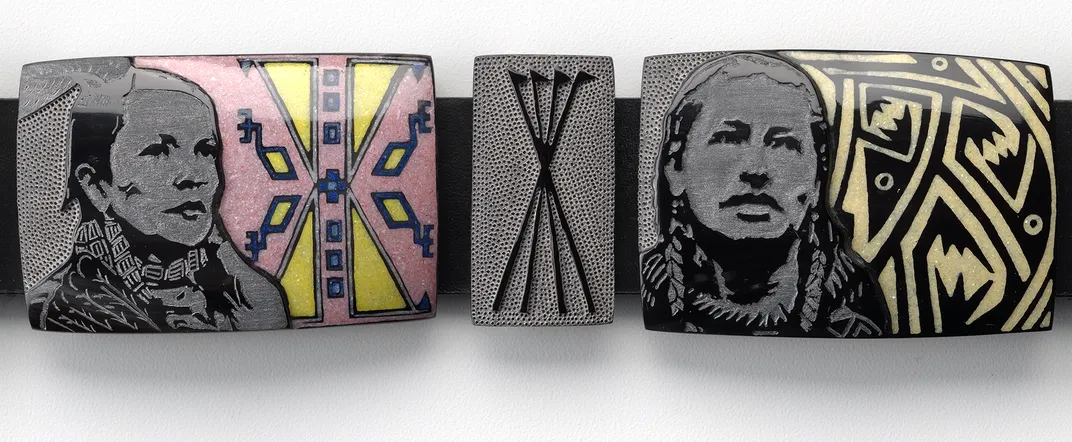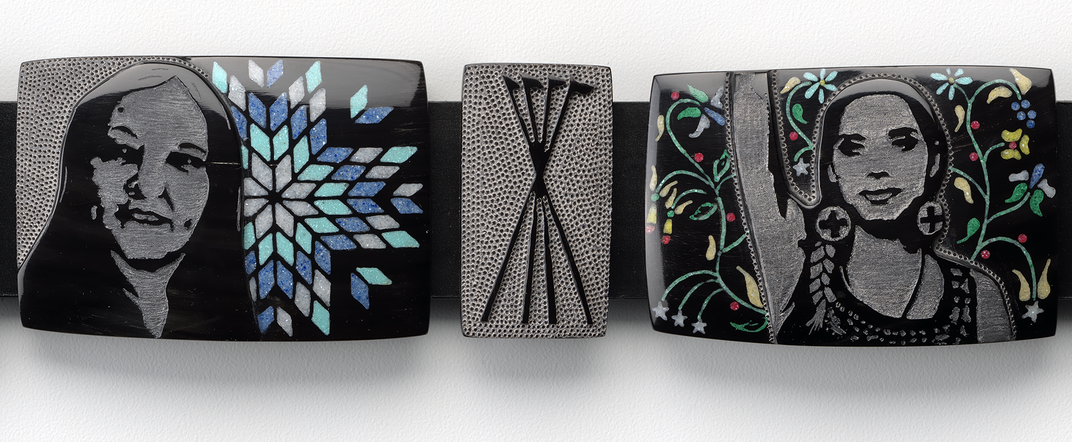NATIONAL MUSEUM OF THE AMERICAN INDIAN
Winyan (Woman) Power: New Art by Kevin and Valerie Pourier Honors Women Who Stand Up for the Rights and Welfare of Others
“Winyan Wánakikśin” (Women Defenders of Others), a buffalo horn belt created by Lakota artists Kevin and Valerie Pourier, honors the strength and perseverance of women activists. Inspired by the Native women who took part in the Dakota Access Pipeline protests, the art work represents an important event in Native American, American, and environmental history, and speaks across artistic, cultural, and national boundaries.
/https://tf-cmsv2-smithsonianmag-media.s3.amazonaws.com/blogging/featured/Pourier_belt_round_1920_x_1080.png)
Women have influenced and shaped events and eras throughout American history. Yet women’s experiences, contributions, and perspectives have been overlooked in our history’s telling. Countless American women’s stories have not been fully integrated into our national narrative, a fact that is even truer for Native American women. To address this issue and “transform our nation’s understanding of its past,” last year the Smithsonian launched the American Women’s History Initiative. The initiative calls on the Smithsonian’s museums and galleries to present the American story in a more inclusive and accurate manner by elevating the stories of American women.
Toward that end, the National Museum of the American Indian just put on prominent display Winyan Wánakikśin, a buffalo horn belt made by Lakota artists Kevin and Valerie Pourier to honor the strength and power of Native women. Created in 2018 and judged Best of Show at the Santa Fe Indian Market last August, the belt was chosen by Kevin Gover, director of the museum, to be included in the museum’s collections as an outstanding work of contemporary art and compelling representation of American women’s history. Visitors to the museum on the National Mall in Washington will see the belt as they enter the Potomac Atrium.
The Pouriers translate the Lakota phrase winyan wánakikśin to mean “women defenders of others.” In Lakota thought, winyan represents the concept of woman as the first spirit of creation and the foundation of all people. The Pouriers intend the title to refer to contemporary Native women who “have made invaluable contributions not only to their individual communities, but for the rights and welfare of Indigenous communities across the United States.”
The belt is composed of nine buffalo horn conchas—a buckle showing the Earth and eight portrait conchas, each carved with the likeness of a Native woman particularly admired by the Pouriers and friends of theirs throughout the United States. In the same way that they are grateful for the strength and presence of winyan, the Pouriers are grateful for the dedication and achievements of these Native women.

Susie Silook (Yupik and Inupiaq) is an activist, writer, and artist. The ivory and whalebone carvings for which she is best known explore both her cultural heritage and contemporary Native issues. Silook essentially introduced the female form to the ancient Yupik and Inupiaq traditions of ivory carving. She has focused her work even further to address the difficult subject of violence against Native women and girls, who experience higher rates of violence and abuse than any other female population in the country.
Language preservationist Tipiziwin Tolman (Wichiyena Dahkota and Hunkpapa Lakota) lives and works on the Standing Rock Indian Reservation. “Although raised right here in our ancestral homelands,” Tolman says, many Lakota people “are essentially outsiders in our own communities’ spaces, our own prayer spaces, without our language.” Committed to the belief that language revitalization is critical to her community’s healing and well-being, Tolman teaches at the Lakota Language Immersion School on the campus of Sitting Bull College.

Mary Kathryn Nagle (Cherokee Nation) is a lawyer dedicated to protecting the rights of Native individuals and the sovereign rights of tribal governments. Director of the Indigenous Performing Arts Program at Yale University, Nagle is the writer and producer of several plays on American Indians and the law, including Waaxe’s Law, Manahatta, My Father’s Bones (written with Suzan Shown Harjo), Miss Lead, Fairly Traceable, Sliver of a Full Moon, and, most recently, Sovereignty.
Tribal leader Wanda Batchelor (Washoe) has had a long career working for the Washoe Tribe of California and Nevada. She was integrally involved in efforts to prevent the damming of one of the last free-flowing reaches of the Bear River and the destruction of one of the last wild salmon runs in California.

Jodi Archambault (Hunkpapa and Oglala Lakota), special assistant for Native American affairs under President Barack Obama, is an advocate for Native Americans. She has worked throughout her career as a policy advisor on Indigenous and tribal issues.
Born into a renowned family of artists, Roxanne Swentzell (Santa Clara Pueblo) is known for her expressive clay sculptures, and for her deep interest in the environment and in Indigenous knowledge regarding its care and preservation.
A prominent voice on American Indian issues since the 1970s, Suzan Shown Harjo (Cheyenne and Hodulgee Muscogee) has helped create key legislation protecting Native sovereignty. She is also a founding trustee of the National Museum of the American Indian. In 2014 Harjo received the Presidential Medal of Freedom.
Bobbi Jean Three Legs (Hunkpapa Lakota) made a name for herself and other young activists by running 2,000 miles across the United States to raise awareness and gather signatures to stop construction of the Dakota Access Pipeline.
This last fact is important: The Pouriers were inspired to create Winyan Wánakikśin by the many Native women who took part in the Dakota Access Pipeline (DAPL) protests at Standing Rock, North Dakota, two years ago. At issue was construction of an oil pipeline across Lake Oahe, just upstream of Standing Rock Sioux tribal lands. The Pouriers wanted to honor the strength and perseverance they witnessed daily among Native women at the DAPL protest camp. “They just worked and worked and worked,” Kevin Pourier told the Santa Fe New Mexican during Art Market. “And then they’d get up on the road and march in front of the National Guard and the oil companies, and they were getting attacked by dogs, and maced. . . . I wanted to portray that strength in this piece.”
The protests, which began in April 2016 and ended in February 2017, were triggered by the potential impact of oil leaks. The Standing Rock Sioux argue that the pipeline route poses a serious threat to their tribal members’ health, safety, and well-being, and that the pipeline’s construction undermines the tribe’s treaty-protected rights to the integrity of their homelands and the waters that sustain them.
The DAPL protests galvanized Native and non-Native people in the tribe’s support. News of the confrontation quickly reached a global audience. It was an unprecedented event, a tribe pitted against one of the nation’s largest energy partnerships, and Native and non-Native environmentalists against a powerful coalition of pipeline backers. The Pouriers’ artistic engagement with this moment in Native American, American, and environmental history further helps distinguish Winyan Wánakikśin as a unique and important work of art and allows it to speak across artistic, cultural, and national boundaries.
At the same time, each of the portraits etched into buffalo horn has its own story and theme. Each deftly combines the likeness of an individual woman with materials and images meaningful to her, ideas that animate not just her portrait, but her world as well. Buffalo horn is itself deeply symbolic, selected by the Pouriers because of its ceremonial use among Lakota people. The buffalo horn conchas were first polished to a high gloss finish, then etched using a diamond-coated carving burr. The technique produced a finely detailed photorealism effect and portraits with a high degree of representational verisimilitude. Colors inlaid into the horn were made from ground stones and shells.
The tipi frame design repeated between the portrait conchas represents winyan in Lakota belief, the Pouriers explain, “as she is the backbone of the world.” The design on the buckle represents the outstretched hands of women from all corners of the Earth “standing up, and speaking out, and regaining their strength and power,” Kevin Pourier says. “This piece isn’t just about Native women. It’s about women from all around the world who are standing up.”
By unifying the stories of eight singular Native American women to honor the remarkable women who made their stand at the DAPL protest—and by extension all Native women, and indeed all winyan power—Kevin and Valerie Pourier created a singular work of art that the National Museum of American Indian could not overlook.


